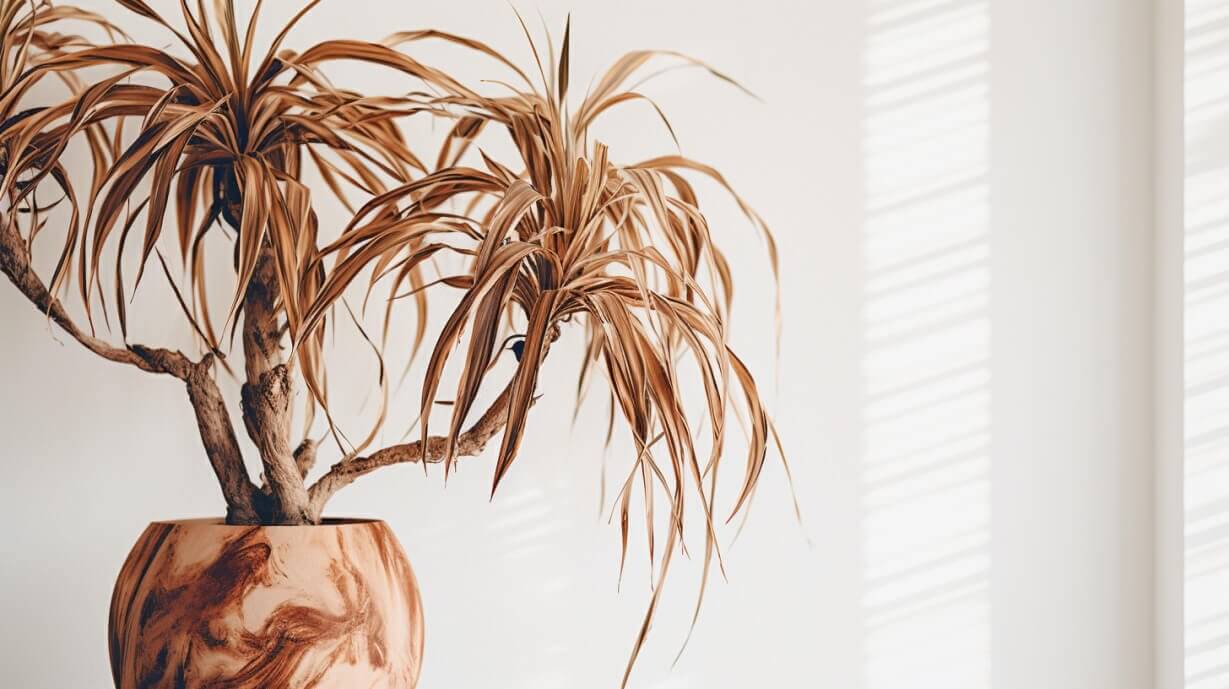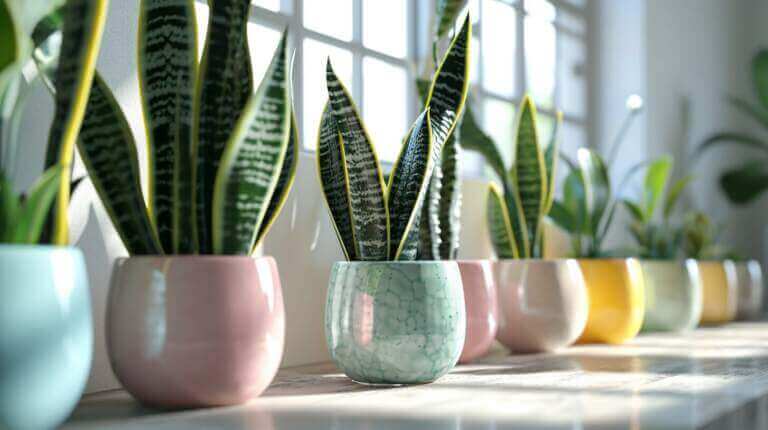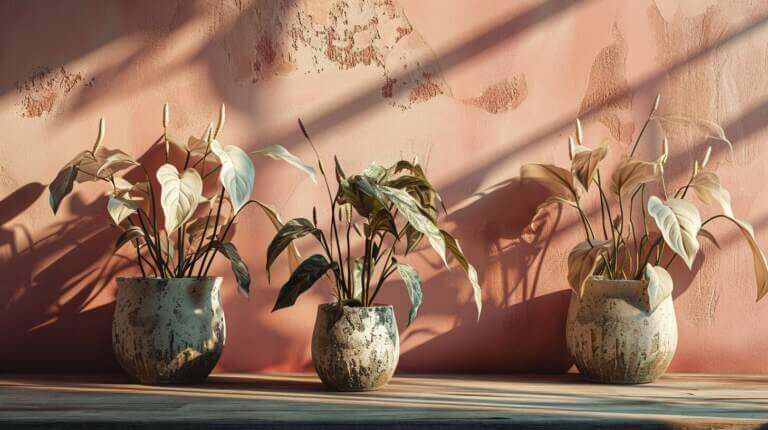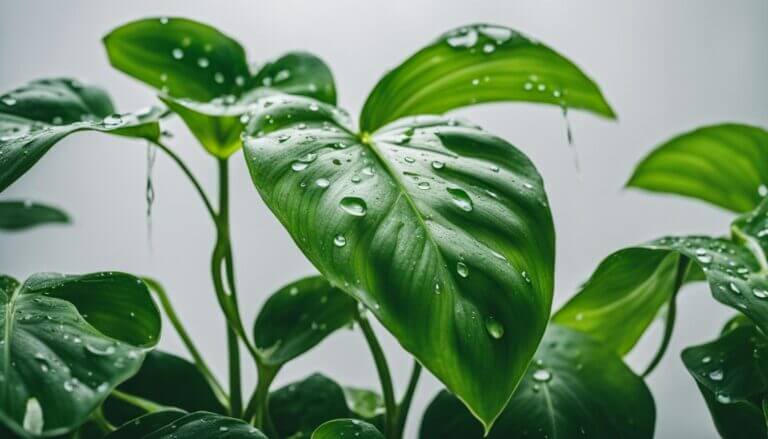If you’ve been wondering why your dracaena leaves are drooping, you’re not alone. Drooping leaves are a common problem with dracaena plants, but understanding the causes and implementing the right solutions can help restore your plant’s vitality.
Key Takeaways:
- Dracaena leaves can droop due to overwatering or underwatering
- Poor soil or pots with inadequate drainage can contribute to drooping leaves
- Temperature extremes and pests can also cause dracaena leaves to droop
- Repotting with well-draining soil and proper drainage holes can help resolve drooping issues
- Monitoring temperature conditions and inspecting for pests is essential for maintaining healthy dracaena plants
Common Causes of Drooping Dracaena Leaves
Several factors can contribute to drooping dracaena leaves, so let’s explore the common causes and their effects on your plant’s health.
1. Overwatering: One of the main culprits behind drooping dracaena leaves is overwatering. When the roots are constantly saturated with water, they can develop root rot, leading to wilting and drooping leaves. It is crucial to allow the soil to dry out between waterings and ensure proper drainage.
2. Underwatering: On the other hand, underwatering can also cause dracaena leaves to wilt and brown. When the plant doesn’t receive enough water, it struggles to maintain its hydration levels, resulting in drooping leaves. Regularly check the moisture level of the soil and water thoroughly when it feels dry.
3. Poor soil or drainage: Dracaenas thrive in well-draining soil, and pots without proper drainage can exacerbate drooping leaves. When water is unable to flow freely through the soil or drain out of the pot, it can accumulate, leading to root rot and wilting leaves. Repotting the plant with well-draining soil and using pots with drainage holes can help alleviate this issue.
4. Temperature extremes and pests: Dracaenas are sensitive to temperature extremes, and drastic fluctuations can cause the leaves to droop. Additionally, pests like spider mites and mealybugs can infest the plant, causing stress and drooping leaves. Monitor temperature conditions and inspect your plant regularly for signs of pests.
To maintain a healthy dracaena plant and prevent drooping leaves, ensure you water correctly, use well-draining soil, monitor temperature conditions, and keep an eye out for pests. Using distilled water or filtering tap water can also help prevent issues caused by chlorine and minerals that may affect the plant’s health.
Solutions for Dracaena Drooping Leaves
Restoring your dracaena plant’s health and preventing drooping leaves is possible with the right solutions. Here are some effective ways to address the causes and promote a healthier dracaena.
- Proper watering techniques: Dracaenas are sensitive to water levels, so it’s crucial to find the right balance. Overwatering can lead to root rot, causing wilting and drooping leaves. On the other hand, underwatering can result in leaves wilting and browning. To avoid these issues, water your dracaena thoroughly, allowing excess water to drain from the pot. Stick your finger about an inch into the soil to check for moisture before watering. If it feels dry, it’s time to water the plant.
- Repotting with well-draining soil: Poor soil or pots with inadequate drainage can contribute to drooping dracaena leaves. To improve the plant’s health, consider repotting it with well-draining soil. This will help prevent water from accumulating and causing root problems. Choose a pot with proper drainage holes to ensure excess water can escape.
- Monitoring temperature conditions: Temperature extremes can take a toll on a dracaena plant, leading to drooping leaves. These plants prefer temperatures between 60 and 75 degrees Fahrenheit (15-24 degrees Celsius). Avoid placing them near drafty windows, heating vents, or air conditioning units. Maintain a consistent temperature to promote healthy growth and prevent leaf drooping.
- Inspecting for pests: Pests, such as spider mites and mealybugs, can also cause dracaena leaves to droop. Regularly inspect your plant for any signs of infestation, such as webs or tiny insects. If pests are present, treat the plant with an appropriate insecticide or try natural remedies like neem oil or insecticidal soap.
Natural Pest Control Recipe
Mix 1 teaspoon of mild liquid dish soap with 1 quart of water. Pour the solution into a spray bottle and thoroughly coat the affected parts of the dracaena plant. Repeat this process every few days until the infestation is under control.
By following these solutions, you can help restore your dracaena plant’s health and enjoy lush, vibrant leaves once again.
| Causes of Drooping Leaves | Solutions |
|---|---|
| Overwatering | Water thoroughly and allow excess water to drain. Check soil moisture before watering. |
| Underwatering | Water the plant adequately to prevent wilting and browning leaves. |
| Poor soil or inadequate drainage | Repot the plant with well-draining soil and choose a pot with proper drainage holes. |
| Temperature extremes | Maintain consistent temperatures between 60 and 75 degrees Fahrenheit (15-24 degrees Celsius). |
| Pests | Inspect the plant regularly for pests and treat with appropriate insecticides if needed. |
Preventative Measures for Healthy Dracaena Plants
To prevent further instances of dracaena leaves drooping, it’s essential to create optimal conditions for your plant’s growth. Here are some preventative measures you can take to maintain a healthy dracaena.
- Watering: Dracaena plants prefer to be slightly moist but not waterlogged. Overwatering can lead to root rot and drooping leaves, while underwatering can cause wilting and browning. Water your dracaena thoroughly, allowing excess water to drain from the pot. Check the moisture level of the soil by sticking your finger about an inch deep. If it feels dry, it’s time to water.
- Soil and Drainage: Use well-draining soil to prevent water from pooling around the roots. Poor soil or pots without proper drainage holes can contribute to drooping leaves. Consider repotting your dracaena using a mixture of potting soil, perlite, and peat moss to improve drainage. Ensure the new pot has sufficient drainage holes to allow excess water to escape.
- Temperature: Dracaena plants thrive in temperatures between 60°F and 80°F (15°C to 27°C). Avoid placing your dracaena near drafty doors or windows, as sudden temperature changes can cause leaves to droop. Keep the plant away from heating or cooling vents as well.
- Pest Control: Monitor your dracaena for common pests like spider mites and mealybugs, which can cause leaves to droop and wither. Regularly inspect the plant for any signs of infestation, such as webbing or tiny bugs. If pests are present, treat them with insecticidal soap or neem oil, following the product instructions carefully.
Watering Tips and Tricks
When it comes to watering your dracaena, consistency is key. Here are a few tips to help you establish a proper watering routine:
- Water your dracaena thoroughly until the water drains out from the bottom of the pot. This helps flush out excess salts and prevents the buildup of toxins in the soil.
- Don’t let your dracaena sit in standing water, as it can lead to root rot. Empty the saucer or tray underneath the pot after watering.
- Keep in mind that dracaena plants are more susceptible to overwatering during the winter months when they are in their dormant period. Adjust your watering frequency accordingly.
- If you’re unsure whether to water, it’s better to err on the side of underwatering. Dracaenas are more tolerant of dry conditions compared to being waterlogged.
By following these preventative measures, you can promote the health and vitality of your dracaena plant, ensuring that its leaves remain vibrant and upright. Remember to provide adequate light exposure, choose the right pot size, and use distilled water or filter tap water to prevent issues caused by chlorine and minerals. With proper care, your dracaena will thrive and add a touch of greenery to your home or office.
| Preventative Measures | Benefits |
|---|---|
| Proper watering techniques | Prevents root rot and wilting |
| Well-draining soil and adequate drainage | Prevents waterlogging and maintains healthy roots |
| Monitoring temperature conditions | Prevents stress and leaf drooping from extreme temperatures |
| Inspecting for pests | Prevents infestations that can lead to leaf damage |
Troubleshooting Common Issues
Despite your best efforts, you may still encounter some common issues with your dracaena that can result in drooping leaves. Let’s troubleshoot these problems and find effective solutions to keep your plant thriving.
Brown Tips: If you notice brown tips on your dracaena leaves, it could indicate dry air or low humidity. To combat this, place a humidifier near your plant or mist the leaves regularly to increase moisture levels. Avoid placing your dracaena near drafts or heating vents, as these can also dry out the leaves.
Yellow Leaves: Yellow leaves can be a sign of overwatering or underwatering. Check the soil moisture level by inserting your finger about an inch deep into the soil. If it feels dry, it’s time to water your plant. If it feels moist, hold off on watering for a few more days. Adjust your watering schedule accordingly to ensure your dracaena is getting the right amount of moisture.
Leaf Drop: Dropping leaves can occur due to stress, such as changes in temperature or lighting conditions. Make sure your dracaena is not exposed to extreme hot or cold temperatures and is placed in an area with bright indirect light. Avoid placing it in direct sunlight, as this can scorch the leaves. Providing a stable environment will help prevent leaf drop.
Leaning Dracaena: If your dracaena is leaning to one side, it may be due to uneven growth or inadequate light. Rotate your plant every few weeks to encourage even growth and ensure each side receives equal exposure to light. If your dracaena is reaching towards a light source, consider moving it to a spot with better lighting conditions to help it grow upright.
By addressing these common issues and implementing the appropriate solutions, you can ensure your dracaena remains healthy and vibrant, with leaves that stand tall and proud. Remember to monitor your plant’s watering, lighting, and temperature needs, and provide the necessary care to keep it thriving.
FAQ
Why are my dracaena leaves drooping?
Dracaena leaves can droop due to watering issues, such as overwatering or underwatering. Other factors that can cause drooping leaves include poor soil or pots with inadequate drainage, temperature extremes, and pests.
What can cause overwatering of dracaena plants?
Overwatering can occur when the plant is watered too frequently or when the pot does not have proper drainage, causing the roots to become waterlogged. This can lead to root rot and wilting, drooping leaves.
How can I prevent overwatering my dracaena plant?
To prevent overwatering, water the dracaena plant thoroughly and wait for the excess water to drain from the pot. Ensure that the pot has proper drainage holes and the soil used is well-draining. Avoid watering too frequently and always check the moisture level of the soil before watering again.
What can cause underwatering of dracaena plants?
Underwatering can happen when the plant is not receiving enough water or when the potting soil dries out completely. This can result in wilting and browning of the dracaena leaves.
How can I prevent underwatering my dracaena plant?
To prevent underwatering, water the dracaena plant thoroughly when the top inch of soil feels dry. Ensure that the soil retains moisture but is not constantly wet. Maintain a regular watering schedule, but avoid letting the soil dry out completely between waterings.
How can poor soil or inadequate drainage affect dracaena leaves?
Poor soil or pots with inadequate drainage can prevent excess water from draining properly. This can lead to waterlogged roots, root rot, and drooping leaves. The lack of proper drainage can also cause salts and minerals to accumulate in the soil, further affecting the health of the plant.
How can I improve soil drainage for my dracaena plant?
To improve soil drainage, repot the dracaena plant using well-draining soil specifically formulated for houseplants. Ensure that the new pot has proper drainage holes to allow excess water to escape. Avoid using heavy clay pots, as they can retain too much moisture.
Can temperature extremes cause dracaena leaves to droop?
Yes, temperature extremes can affect the health of dracaena plants, causing wilting and drooping leaves. Dracaenas prefer average room temperatures between 60-75°F (15-24°C) and can suffer if exposed to extreme heat or cold.
How can I prevent temperature extremes from affecting my dracaena plant?
To prevent temperature extremes, avoid placing your dracaena plant near drafts, heaters, or air conditioning vents. Maintain a consistent room temperature within the recommended range. Protect your plant from cold drafts during winter months.
Can pests cause dracaena leaves to droop?
Yes, pests such as spider mites, mealybugs, and scale insects can infest dracaena plants and cause damage to the leaves. This can result in wilting, drooping, and discoloration.
How can I prevent and treat pest infestations on my dracaena plant?
To prevent pests, regularly inspect your dracaena plant for signs of infestation. If pests are present, isolate the affected plant and use appropriate insecticidal soaps or natural pest control methods to eliminate the infestation. Keep your plant clean and dust-free to discourage pests.
Can the quality of water affect dracaena leaves?
Yes, the chlorine and minerals present in tap water can cause issues for dracaena plants, leading to drooping leaves. Using distilled water or filtering tap water can help prevent these problems.
How can I ensure the water quality for my dracaena plant?
To ensure water quality, you can use distilled water or filter tap water to remove chlorine and minerals that can harm your dracaena plant. Avoid using water that has been treated with water softeners, as they may contain excess salts that can affect the plant’s health.







